Eight essential wrist strap testing methods will help protect your sensitive electronics from static damage. You'll need to perform daily resistance testing within 800k-10M ohms, implement continuous monitoring for real-time feedback, and conduct pre-shift visual inspections. Digital test stations with automated data collection, combo testers for simultaneous footwear checks, and near-fail detection systems add vital safety layers. Don't forget proper calibration verification, authentication protocols, and dual-wire testing standards. Following these methods guarantees your ESD protection stays reliable and compliant – there's much more to discover about maximizing your static control effectiveness.
Daily Resistance Testing Protocol
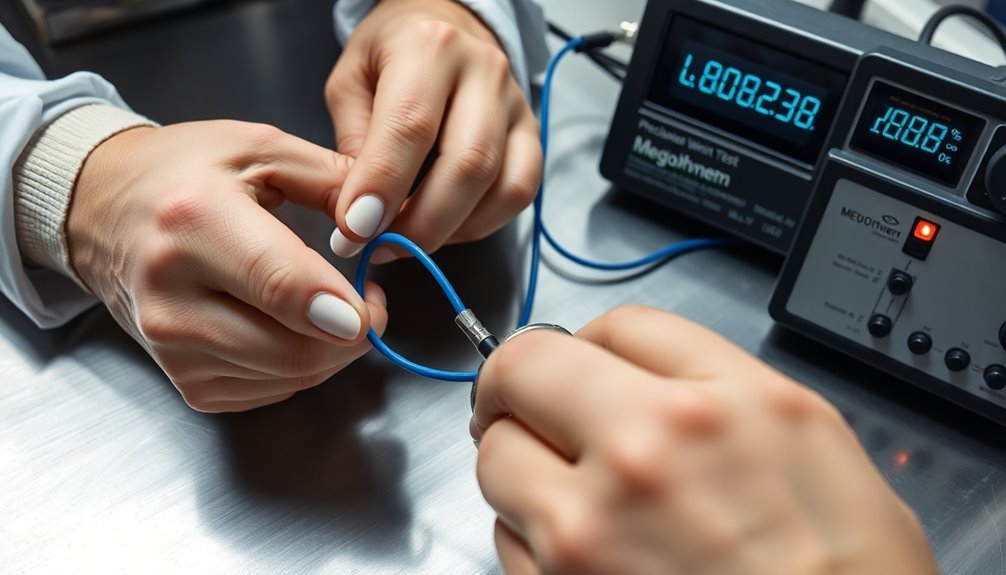
Safety professionals mandate daily testing of wrist straps to guarantee consistent ESD protection in the workplace. You'll need to follow specific protocols to verify your wrist straps meet the required standards set by ANSI/ESD S20.20 and IEC 61340-5-1.
To perform your daily test, you'll use a wrist strap tester that measures resistance within the 800 kilohms to 10 megohms range. Connect your wrist strap to the tester and touch the metallic surface to complete the circuit path. The tester will display either a green light for pass or red light for fail, making it easy to interpret results. The test verifies that your wrist strap maintains proper skin contact by monitoring the complete grounding path.
Your testing equipment must undergo regular calibration using tools like the ED311 Calibration Tool to maintain accuracy. When measuring, you'll need to account for both the wrist strap's built-in 1 megohm current-limiting resistor and your skin's resistance.
Remember that proper grounding requires resistance below 10 megohms but above 0.5 megohms for safety. If you're using portable testers like the ED698, you'll want to check the battery indicator regularly to guarantee reliable measurements.
This systematic approach helps you maintain consistent ESD protection while preventing electrical hazards.
Continuous Monitoring Systems
While daily testing provides basic ESD protection, continuous monitoring systems offer a superior level of safeguarding for your sensitive electronics. You'll get instant feedback on your wrist strap's status and immediate alerts if any problems arise. These systems can detect split-second failures that periodic testing might miss, like an over-flexed coil cord. The availability of verification kits helps ensure your monitoring systems are functioning correctly.
| Feature | Single-Wire Systems | Dual-Wire Systems |
|---|---|---|
| Cost | More economical | Higher investment |
| Installation | Simple setup | More complex setup |
| Reliability | Good protection | Enhanced protection |
| Monitoring Type | Impedance-based | Resistance-based |
| Best For | Standard applications | Critical operations |
You'll find these monitors available in various configurations, from single-user to multi-user setups, with options to monitor your ESD worksurface simultaneously. They're compatible with most wrist straps and don't require calibration, making them practical for daily use. You'll save time and money by eliminating the need for periodic testing while ensuring continuous protection for your sensitive components. The initial investment pays off through reduced product damage and fewer warranty claims, making continuous monitoring a smart choice for your ESD protection strategy.
Pre-Shift Visual Inspection
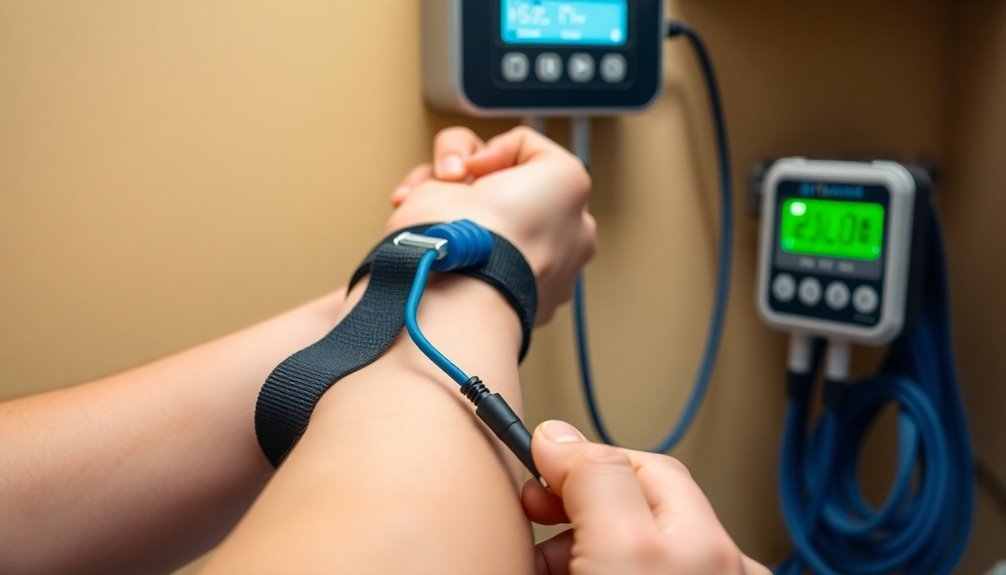
Pre-shift wrist strap inspections form your first line of defense against ESD-related failures. You must systematically examine your wrist strap system before handling any ESD-sensitive components to prevent potential damage during your shift. This critical step confirms you're working with fully functional protection equipment.
Start your inspection by checking the wrist band for visible damage or wear. You'll need to examine the ground cord carefully, looking for cuts, frays, or exposed wires that could compromise its effectiveness. Regular testing is crucial since broken wires in coils are a common cause of wrist strap failures.
Don't forget to verify the connection points between your wrist strap and ground point, confirming they're secure and clean.
You should conduct these visual inspections daily, as recommended by industry standards like EN 61340-5-1 and ANSI/ESD S1.1-2021.
Use specialized testing equipment such as the ED698 to measure ground resistance accurately. Make sure you're testing all three components: the wrist band, ground cord, and skin interface.
Remember to document your test results for traceability. If you notice any issues during your inspection, replace the faulty components immediately. Don't risk using compromised equipment that could lead to costly ESD damage.
Digital Test Station Methods
Your digital test station's automated data collection system lets you instantly record and track all wrist strap test results, eliminating manual documentation errors.
With real-time resistance monitoring, you'll receive immediate alerts if your wrist strap falls outside the acceptable range of 750kΩ to 10MΩ during operations.
User authentication integration guarantees you're maintaining compliance by confirming operator identity and tracking individual testing histories across your facility. Annual calibration procedures ensure your digital test station maintains accurate resistance measurements over time.
Automated Data Collection Systems
Through modern digital test stations, automated data collection systems revolutionize wrist strap testing with enhanced accuracy and efficiency. You'll find these systems integrate seamlessly with portable battery-powered tools while enforcing critical ESD safety standards like EN 61340-5-1 and ANSI/ESD S1.1. The system's exceptional diagnostic accuracy helps technicians identify precise fault locations during testing.
| Feature | Benefit |
|---|---|
| High-Performance Testing | Up to 3,840 pins with exceptional diagnostic accuracy |
| Real-time Monitoring | Instant LED indicators for resistance readings |
| Data Logging | Tracks maintenance needs and compliance records |
| System Integration | Compatible with larger test systems and legacy programs |
These automated systems provide immediate feedback through LED indicators – green for proper resistance between 800k ohms and 10 megohms, and red with an alarm for out-of-range readings. You'll benefit from the system's ability to collect and store testing data, which helps in maintenance planning and compliance documentation.
When troubleshooting, you can quickly identify issues through the system's diagnostic capabilities. If readings are problematic, you can test individual components separately and apply ESD lotion when necessary. The scalable nature of these systems means you can configure them to match your specific testing requirements while maintaining high throughput and accuracy.
Real-Time Resistance Monitoring
Real-time resistance monitoring represents a significant advancement in wrist strap testing technology, offering immediate feedback and continuous protection against ESD risks.
You'll get instant alerts if your wrist strap fails, allowing you to address issues before they cause permanent damage to sensitive components.
When you're using a digital test station, you can measure resistance within specific ranges that comply with IEC 61340-5-1 specifications. These stations efficiently test both your wrist strap and coil cord while providing accurate digital readouts in Ohms. Daily testing requirements make these stations an essential part of any ESD control program.
You'll find them conveniently wall-mounted and powered by a 9V battery for reliable operation.
The near-fail detection system adds another layer of protection to your testing routine. It'll warn you when your grounding devices are approaching failure levels, letting you take preventive action.
You can test your wrist strap while wearing it, which provides the most accurate assessment of the entire system, including the band, ground cord, and your skin's connection.
Don't forget to use ESD lotion to improve skin contact and maintain a reliable common point ground for peak performance.
User Authentication Integration
Modern digital test stations integrate sophisticated user authentication systems to enhance ESD safety protocols and access control. You'll find proximity card readers that verify operator identities before testing begins, confirming only authorized personnel can access sensitive areas.
When you approach the test station, it'll recognize your credentials and automatically apply the appropriate testing protocols based on your role. These systems must ensure readings are less than 3.5×10^7 ohms for proper wrist strap functionality.
The system tracks your test results in real-time, storing data for future analysis and compliance verification. If you fail a test, the station immediately alerts supervisors and prevents access through connected turnstiles or gates.
You can easily monitor your test history and track the service life of your wrist strap through the station's detailed display interface. The system's automated logging features help you maintain thorough records of all tests performed, supporting your facility's ESD control program.
For enhanced hygiene, you'll benefit from contactless testing options that use infrared technology, minimizing surface contact while maintaining accurate results.
The integration of user authentication confirms you're following proper ESD safety procedures while creating an efficient, automated workflow that supports both individual accountability and facility-wide safety compliance.
Combo Tester Verification Process
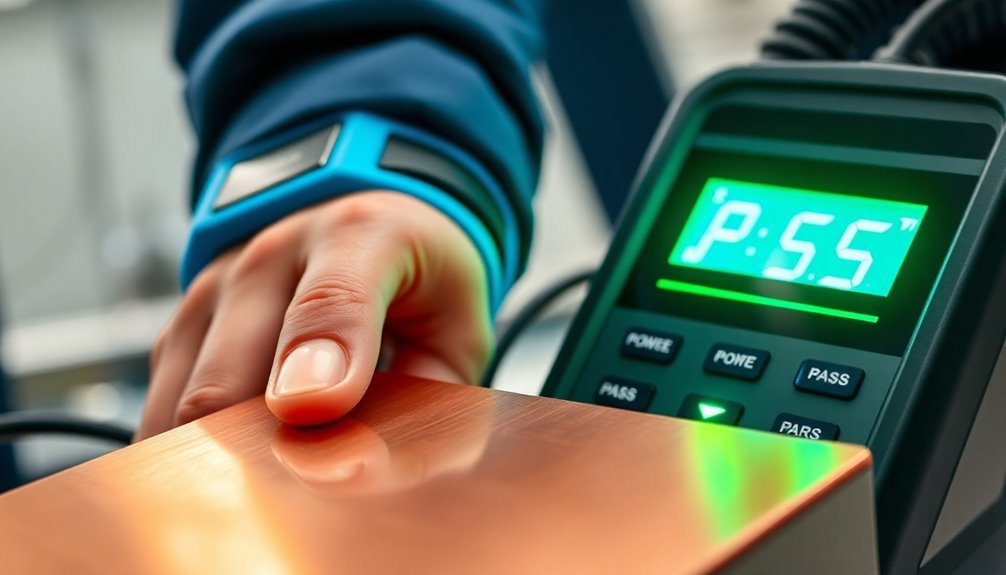
A thorough combo tester verification process guarantees reliable ESD protection by validating both wrist straps and footwear simultaneously. You'll need to certify that your equipment operates within the factory-set limits of 750kΩ – 10MΩ for wrist straps and 750kΩ – 35MΩ for footwear to maintain compliance with ANSI/ESD S20.20 standards. Many facilities enhance security by implementing access control integration with electronic doors and turnstiles.
| Test Component | Acceptable Range | Common Issues |
|---|---|---|
| Wrist Straps | 750kΩ – 10MΩ | Dry skin contact |
| Footwear | 750kΩ – 35MΩ | Poor sweat layer |
| Calibration | ±10% accuracy | Expired certification |
| Ground Path | Continuous | Loose connections |
You'll need to perform daily testing before entering ESD-protected areas. If you encounter a "FAIL LOW" or "FAIL HIGH" reading, try using ESD hand lotion for wrist straps or taking a short walk to improve footwear conductivity. Remember to verify your tester's calibration every 6-12 months using a NIST traceable Limit Comparator. For extensive protection, you should maintain detailed records of all test results, especially if your system includes data logging capabilities for audit purposes.
Near-Fail Detection Techniques
Building upon standard combo tester procedures, near-fail detection techniques offer a more sophisticated level of preventive maintenance for your ESD protection program. You'll benefit from early warnings when your grounding devices approach failure thresholds, typically set at 10% of the acceptable range limits.
Your near-fail detection system will display actual resistance measurements in ohms through an LCD screen, allowing you to monitor trends and take action before complete failure occurs. You can adjust the testing ranges (typically 100K~1G) to match your specific requirements while maintaining compliance with ANSI ESD S20.20 standards.
When you're using combination testers with near-fail detection, you'll get independent readings for both wrist straps and footwear. If you receive a near-fail alert, you should immediately troubleshoot by testing the wristband and cord separately.
Check your banana jack connections, verify cord continuity with an ohmmeter, and verify your tester is properly calibrated.
Don't ignore near-fail warnings – they're designed to prevent unexpected failures in your EPA. Clean or replace wrist straps showing high readings, and maintain secure connections to guarantee continuous protection against electrostatic discharge.
Dual-Wire Testing Standards
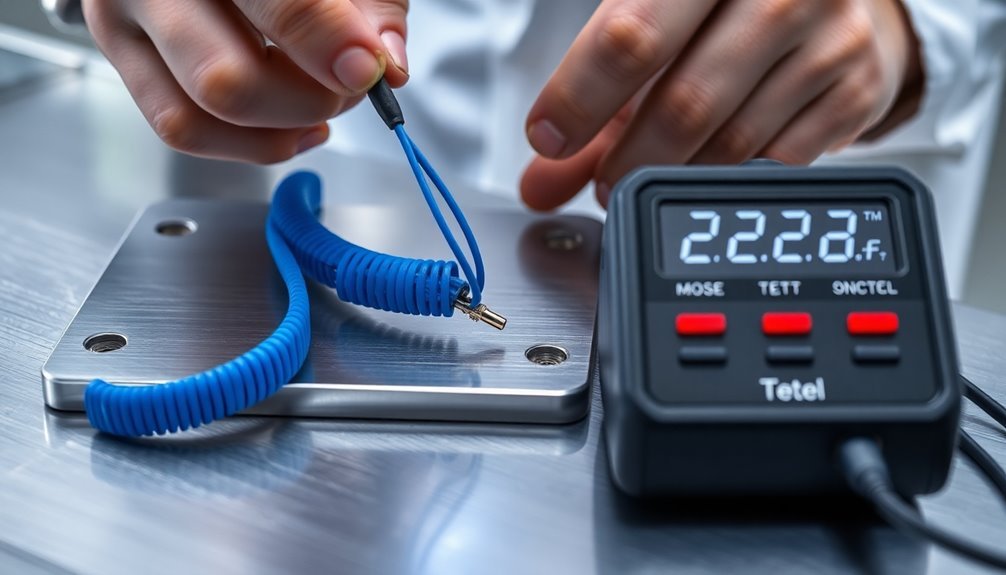
State-of-the-art dual-wire testing standards provide enhanced reliability through redundant grounding paths and continuous monitoring capabilities. You'll need to test your dual-wire wrist straps daily unless you're using continuous monitoring systems. When testing, verify the resistance measures less than 500 ohms for proper grounding protection.
| Testing Parameter | Requirement |
|---|---|
| Testing Frequency | Daily check or continuous monitoring |
| Resistance Limit | Less than 500 ohms |
| Inspection Points | Band wear, cord integrity |
| Compliance Standards | ESDA S1.1, EIA 625, ANSI ESD S-20.20 |
Your dual-wire system includes two separate conducting paths through the band and cord, guaranteeing you're protected even if one path fails. The wrist strap's components include adjustable fabric bands with conductive threads, stainless steel back plates, and a dual-wire coil cord with a current-limiting resistor. You'll find a right-angle mono plug that prevents cord damage during use.
When you implement these testing standards, you're complying with industry requirements while maintaining continuous protection against ESD risks. Your dual-wire system's continuous monitoring capability will alert you immediately if there's a grounding failure, guaranteeing uninterrupted protection for sensitive components.
Calibrated Equipment Testing
Reliable calibrated equipment testing starts with properly certified instruments traceable to NIST standards. You'll need to guarantee your testing equipment maintains an accuracy range of ±15% or ±5%, depending on your specific requirements.
Regular calibration verification using resistance decade boxes and test leads will confirm your tester operates within specifications.
To perform effective testing, you'll connect the wrist strap cord to the test jack and press the test button to complete the circuit path. Your equipment should display clear LED indicators – green for pass and red for fail – corresponding to the measured resistance values. Don't forget to check the battery indicator, as low power can affect testing reliability.
When selecting testing equipment, you'll find both portable and wall-mounted options. Most units run on 9V batteries and feature simple push-to-test operation.
To maintain compliance with ESD S20.20 and EN 61340-5-1 standards, you must establish a regular calibration schedule based on how critical your ESD-sensitive items are. Remember to perform daily wrist strap tests to guarantee continuous path-to-ground integrity.
Your compliance verification plan should document all calibration procedures and testing frequencies to meet industry requirements.
Frequently Asked Questions
How Long Does a Typical Wrist Strap Last Before Needing Replacement?
Your wrist strap's lifespan typically ranges from 1.5 to 2 years for leather straps, while metal bracelets can last up to 20 years. You'll need to replace it sooner if you notice wear or damage.
Can Wrist Straps Be Shared Between Different Employees During Shifts?
You shouldn't share wrist straps between employees. It's unsafe and violates safety protocols due to infection risks, inconsistent skin resistance, and hygiene concerns. Each worker needs their own personal wrist strap for proper ESD protection.
What Cleaning Solutions Are Safe to Use on Wrist Strap Bands?
You can safely clean your wrist straps using mild soap and warm water, or a gentle vinegar-baking soda solution. Don't use harsh chemicals or bleach. For leather bands, use specialized leather cleaners only.
Does Wearing Lotion Affect Wrist Strap Effectiveness and Test Results?
ESD-safe lotions can actually improve your wrist strap's effectiveness by enhancing skin conductivity. You'll get better test results when using approved lotions, but be sure to avoid regular cosmetic lotions that could interfere.
Are There Special Storage Requirements for Wrist Straps Between Uses?
You'll need to store your wrist straps in dry, clean conditions away from heat and sunlight. Keep them organized, untangled, and near grounding points. Don't forget to inspect them regularly for damage.
In Summary
You've learned eight reliable methods to test your ESD wrist straps, from basic daily resistance checks to advanced continuous monitoring. By implementing these testing protocols, you'll protect sensitive components and maintain compliance with industry standards. Whether you're using digital stations, combo testers, or dual-wire systems, regular verification guarantees your wrist straps provide consistent protection against costly static discharge damage.

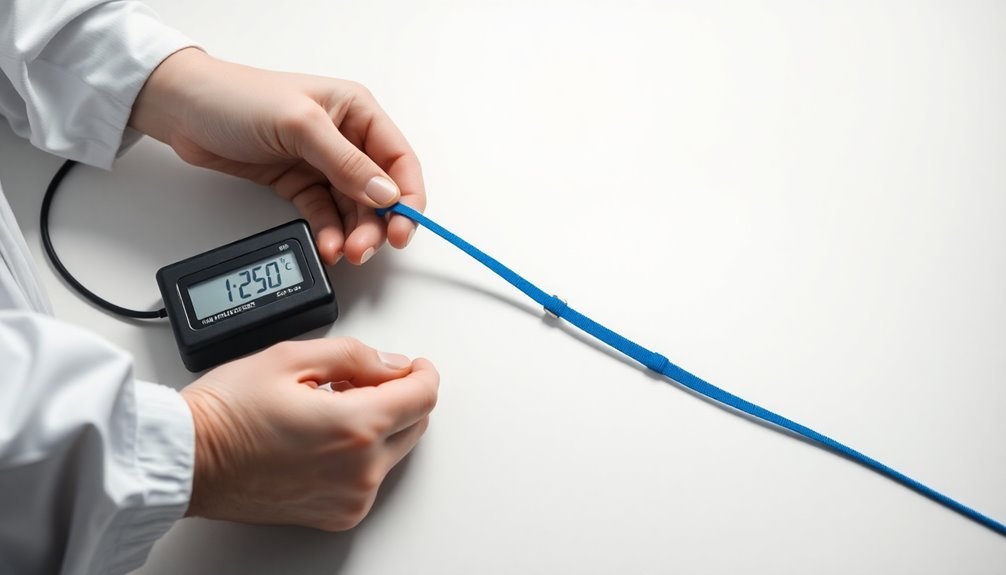



Leave a Reply